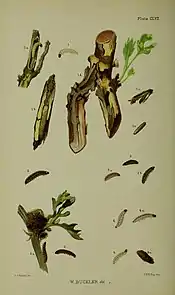| Eurasian sunflower moth | |
|---|---|
.jpg.webp) | |
| Homoeosoma nebulella Moscow oblast | |
| Scientific classification | |
| Domain: | Eukaryota |
| Kingdom: | Animalia |
| Phylum: | Arthropoda |
| Class: | Insecta |
| Order: | Lepidoptera |
| Family: | Pyralidae |
| Genus: | Homoeosoma |
| Species: | H. nebulella |
| Binomial name | |
| Homoeosoma nebulella | |
Homoeosoma nebulella, the Eurasian sunflower moth, is a moth of the family Pyralidae. It is found in Europe, Russia, Anatolia, the Middle East and West Africa. The wingspan is 20–27 mm.

Fig. 2 larva after final moult
The larvae feed on Asteraceae such as Cirsium vulgare, Senecio jacobaea, Tanacetum vulgare and Leucanthemum vulgare. They are a serious pest of the sunflower, Helianthus annuus, in eastern Europe and Ukraine and a potential sunflower pest in France. The caterpillar is grey with a yellow-brown head and three longitudinal stripes on the dorsal side.
References
- ↑ "GlobIZ search". Global Information System on Pyraloidea. Retrieved 7 October 2011.
External links
This article is issued from Wikipedia. The text is licensed under Creative Commons - Attribution - Sharealike. Additional terms may apply for the media files.